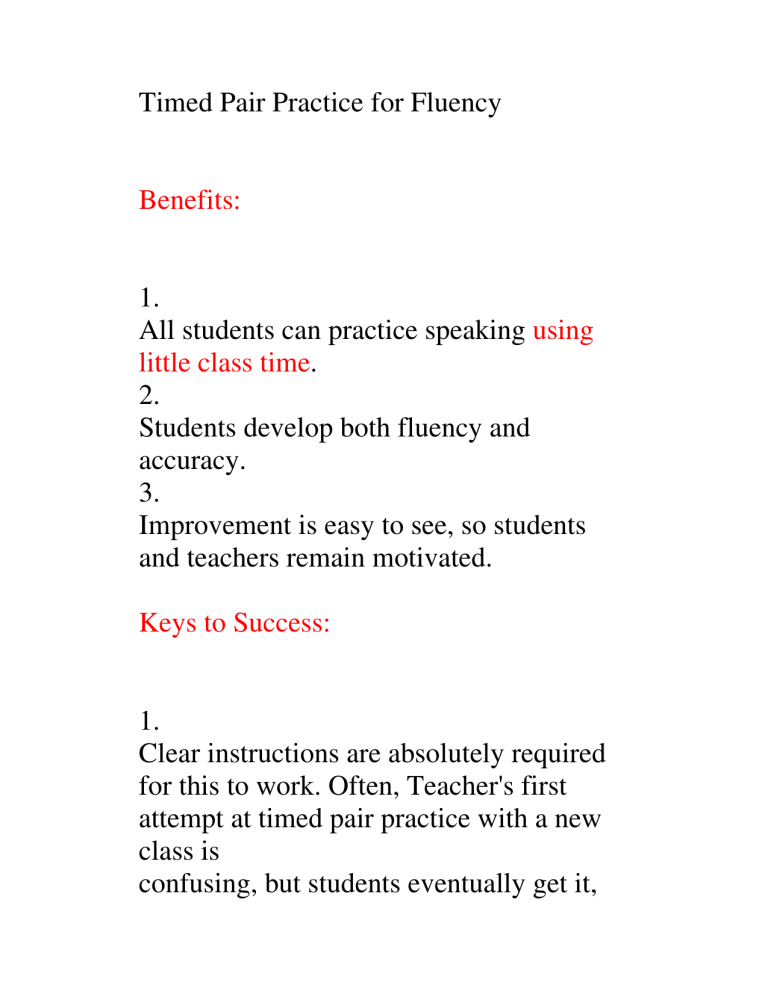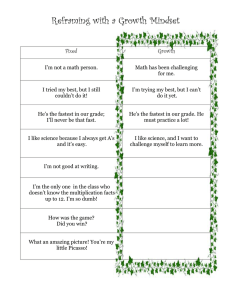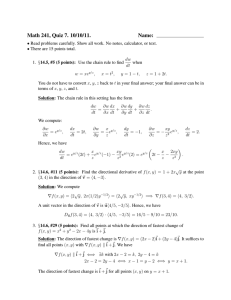
Timed Pair Practice for Fluency Benefits: 1. All students can practice speaking using little class time. 2. Students develop both fluency and accuracy. 3. Improvement is easy to see, so students and teachers remain motivated. Keys to Success: 1. Clear instructions are absolutely required for this to work. Often, Teacher's first attempt at timed pair practice with a new class is confusing, but students eventually get it, so keep trying. By the second or third time, students understand what they must do and do it smoothly. 2. Teachers must be patient in explaining the exact procedure to follow. 3. Start with simple English so students can focus on the process at first. When students understand how to do timed pair practice, you can increase the complexity of the language. Basic Procedure: 1. Choose six (or ten or twelve) questions and divide them into two sets of equal difficulty, A and B. Print them onto two little slips of paper (three questions on one slip, three on the other) to give to students. Here's a simple example: A1. Do you like to play tennis? A2. Do you have any brothers? A3. Do you go to school by bus? B1. Do you like swimming? B2. Do you have any sisters? B3. Do you come to school by bicycle? Teacher prints five sets, for ten students, on one A4 sheet of paper. If you print five such sheets and cut them, you will have enough questions for 50 students. 2. Give the A questions to half of the students, maybe the students in the first, third and fifth rows of your class. Tell them that these questions are "SECRET". (If they show the questions to the other students, then those students will not have to listen later, so this is very important!) 3. Encourage students to ask the three questions "face to face" as in a real conversation, rather than reading directly off the paper. In other words, students must look at a question, remember it, then ask their partner while keeping eye contact. Their partners should answer with complete sentences. 4. Model with a good student using simple questions such as "What is your name?" and "How are you?". The model student should answer with full sentences such as "My name is..." and "I'm pretty good today, thank you". 5. Have students stand up. They begin when you give a signal such as "Three...two...one... GO!" and they may sit down after finishing all three (or five or seven) questions. 6. Use a timer. When one pair sits down, write their time on the blackboard. After about half the students have finished, write down that time too. When almost all, or perhaps all, students have finished, write down the slowest time on the board. (Now you can practice vocabulary such as "fastest" and "slowest" in context!) 7. Have one pair, usually the fastest, stand up and perform for the others. Use the timer to see if they can match or beat the fastest time. See if some other pairs can beat the fastest time. Be sure to check for accuracy and complete sentences. 8. Repeat with the B questions. Those students who were answering will now ask the questions and those who asked will now answer. Usually, the fastest time and the slowest time for Part B will be much better than Part A, because they have practiced. 9. Sometimes repeat the same questions, or use another set of questions with the same structure. The second time, students show dramatic improvement. (When I teach using five questions for each part, the fastest students sometimes take more than 40 seconds, or they take 30 seconds and make many mistakes. The second time, however, the fastest pair takes under 20 seconds and the SLOWEST takes under 40!) 10. Be sure to get the questions back from the students at the end of the activity. That way you can put your hard work to use with other classes! Variations: 1. Make questions based on a story from the textbook. Students must consult the text to find the answers. This improves reading comprehension as well as speaking. 2. Give students a list of ten or more questions, or give students many questions as dictations, then let them choose three or five to do in pairs. 3. Students can write down their own questions, using whatever language is currently being taught. Be sure to give feedback on any strange questions that students may write. Conclusion: The one drawback with this activity is that it might take time to prepare. If possible, work with other teachers to think of and print out enough little "question cards". One teacher can make a pair practice exercise one week, then let other teachers do it the following week. Share your exercises with other teachers and be sure to keep these cards for future classes. This is worth the effort, because watching students speak out quickly and accurately is very impressive! Keep trying Teacher 's Timed Pair Practice until students can do it smoothly, then use it often. You'll be amazed at students' improvement.


